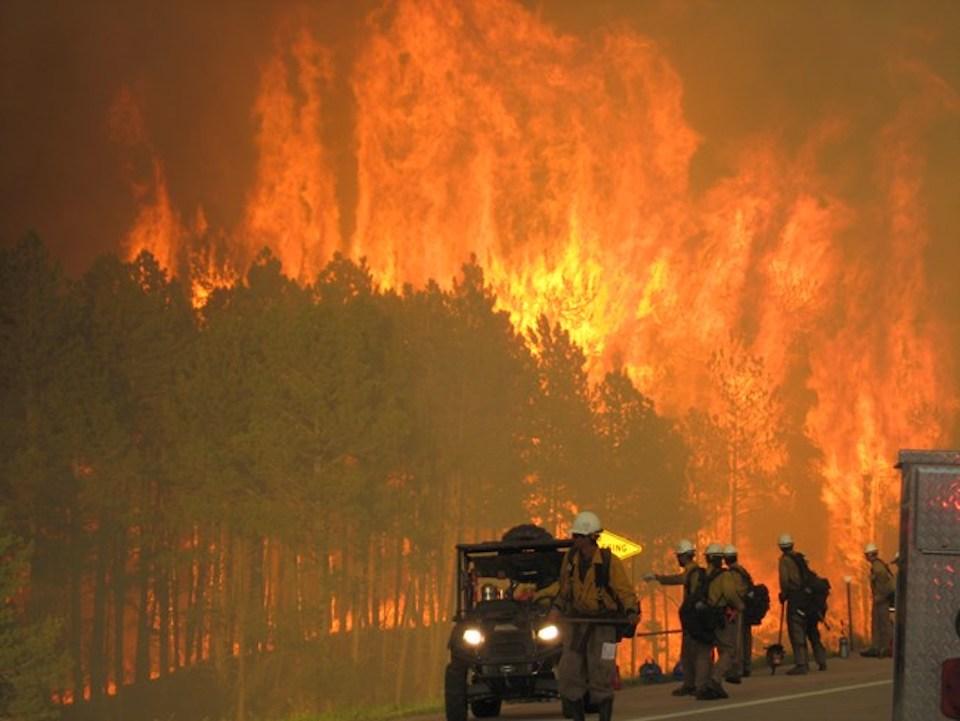
Alpine Hotshots provide initial attack on 2012 Myrtle Fire on the Black Hills National Forest in South Dakota
Editor's note: The following story was written by staff at Rocky Mountain National Park.
As part of the National Park Service’s response to the novel coronavirus, wildland fire staff across the country are getting ready for the upcoming fire season. This summer will be different, presenting a new set of challenges to firefighters as this global pandemic has reshaped how people interact, gather, travel, and work. The NPS Alpine Hotshot Crew, like all wildland firefighters, are looking for innovative ways to mitigate the risk of exposure to firefighters while continuing to provide their essential public service this summer.
“Wildfires are going to happen whether we are ready for it or not,” noted Rocky Mountain National Park Fire Management Officer Mike Lewelling. “Firefighters are essential to protecting lives, resources, and communities. That is why we have to mitigate possible COVID-19 virus exposure for fire personnel.”
Founded in 1981, the Alpine Hotshot Crew was one of the first National Park Service hotshot crews. Over the years, this hotshot crew has been stationed in Arizona, California, and Wyoming and is currently based at Rocky Mountain National Park. Hotshot crews are highly skilled teams consisting of 18-22 wildland firefighters. They provide specialized support on wildland fires across the nation, often responding to the large, high-priority fires and are trained and equipped to work in remote areas for extended periods of time with little logistical support.
Working with the NPS Office of Public Health, the hotshot crew is reviewing every aspect of their operations to mitigate crew members’ risk of exposure to the coronavirus.
“The safety of our firefighters and the public is our No. 1 priority and we are taking COVID-19 very seriously,” said Alpine Hotshot Crew Superintendent James Champ. “Our normal season preparations, including critical training, are being done remotely to maintain social distancing. We are taking a proactive approach to develop strategies so we can be successful at providing a safe and healthy resource to support the interagency wildland fire response.”

Prior to new crew members’ arrival at Rocky Mountain National Park, the NPS implemented measures to reduce the risk of spreading infectious disease. Mitigation efforts included checking incoming personnel’s travel history and health. In addition, new workers checked-in one at time to avoid cross contamination.
This year, the 21-person crew will live, train, and perform daily work tasks in smaller workgroups, helping to maintain social distancing and limit large group interactions. All staff have been placed into housing where they have their own bedroom for at least two weeks after arrival. All critical training is being done remotely while crew members are social distancing at personal residences.
Every crew member takes their temperature in the morning and in the evening to track any potential infections. The crew follows guidance from the CDC and NPS Office of Public Health, including standard operating procedures for disinfecting vehicles, buildings, and equipment at the end of each shift.
When firefighters are responding to an incident, they will bring additional vehicles to carry extra gear to facilitate the crew being as self-sufficient as possible. The idea is to limit all interactions with the public, other firefighters and incident management teams. They will follow the latest CDC guidelines for social distancing when making stops for gas and food. While the hotshot crew is working on an incident, they will be nearly self-sufficient, relying on MREs and their own food, and typically camp in a remote area, removed from other firefighters and staff.
Should an employee begin to exhibit symptoms consistent with COVID-19, that employee will be instructed to separate from the other crew members, follow up with their supervisor, and follow further CDC and NPS guidance for reporting. The Alpine Hotshots have completed their on-boarding process and pre-season training. They are now available for wildfire assignments anywhere in the country they are needed.



Add comment